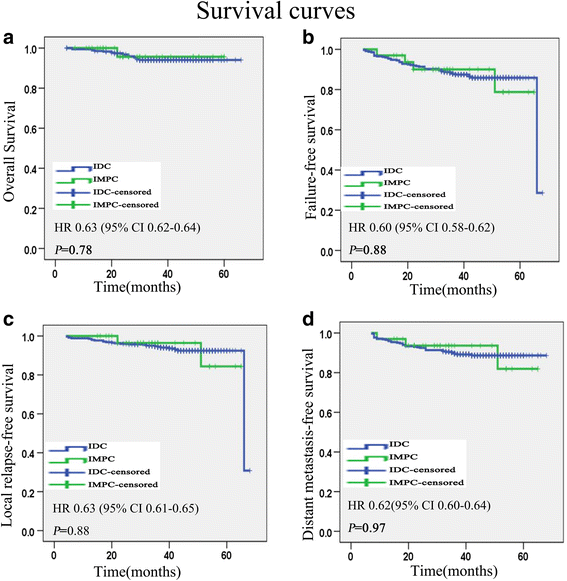Invasive micropapillary carcinoma of the breast had poor clinical characteristics but showed no difference in prognosis compared with invasive ductal carcinoma
- PMID: 27492008
- PMCID: PMC4974796
- DOI: 10.1186/s12957-016-0960-z
Invasive micropapillary carcinoma of the breast had poor clinical characteristics but showed no difference in prognosis compared with invasive ductal carcinoma
Abstract
Background: It is controversial for prognosis of invasive micropapillary carcinoma (IMPC) compared with invasive ductal carcinoma (IDC) of the breast. To better understand the difference between IMPC and IDC prognoses, we conducted this retrospective study.
Methods: Data from 33 patients with IMPC were retrospectively reviewed, and the clinicopathologic characteristics and survival status were compared with those of 347 patients with IDC who were treated during the same period.
Results: The IMPC cases were of larger tumor size, greater proportion of nodal involvement, and an increased incidence of lymphovascular invasion compared with IDC cases. The overall survival (OS), local relapse-free survival (LRFS), distant metastasis-free survival (DMFS), and failure-free survival (FFS) rates were not significantly different between IMPC and IDC. The 3-year OS rate was 97 vs 94.2 % for the IMPC and IDC patients, respectively. The 3-year FFS rate was 87.9 vs 86.2 % for the IMPC and IDC patients, respectively. For IMPC patients, the 3-year LRFS rate was 93.9 % and in IDC patients was 89.0 %. The 3-year DMFS rates of IMPC patients was 90.9 % and IDC patients was 89 %.
Conclusions: IMPC had poor clinical characteristics, but it showed no difference in OS, FFS, LRFS, and DMFS compare with IDC.
Keywords: Breast; Clinical characteristics; Invasive ductal carcinoma; Invasive micropapillary carcinoma; Retrospective study; Survival.
Figures

Similar articles
-
Differences in Prognostic Factors and Failure Patterns Between Invasive Micropapillary Carcinoma and Carcinoma With Micropapillary Component Versus Invasive Ductal Carcinoma of the Breast: Retrospective Multicenter Case-Control Study (KROG 13-06).Clin Breast Cancer. 2015 Oct;15(5):353-61.e1-2. doi: 10.1016/j.clbc.2015.01.008. Epub 2015 Feb 7. Clin Breast Cancer. 2015. PMID: 25776197 Clinical Trial.
-
Comparison of invasive micropapillary and triple negative invasive ductal carcinoma of the breast.Breast. 2015 Dec;24(6):723-31. doi: 10.1016/j.breast.2015.09.001. Epub 2015 Sep 19. Breast. 2015. PMID: 26392199
-
Invasive micropapillary carcinoma of the breast has a better long-term survival than invasive ductal carcinoma of the breast in spite of its aggressive clinical presentations: a comparison based on large population database and case-control analysis.Cancer Med. 2017 Dec;6(12):2775-2786. doi: 10.1002/cam4.1227. Epub 2017 Oct 26. Cancer Med. 2017. PMID: 29072365 Free PMC article.
-
[Intraductal cancer of the breast in women under age 35 years].Bull Cancer. 1996 May;83(5):395-9. Bull Cancer. 1996. PMID: 8680092 Review. French.
-
Invasive micropapillary carcinoma: a distinct type of adenocarcinomas in the gastrointestinal tract.World J Gastroenterol. 2014 Apr 28;20(16):4597-606. doi: 10.3748/wjg.v20.i16.4597. World J Gastroenterol. 2014. PMID: 24782612 Free PMC article. Review.
Cited by
-
A rare case of invasive micropapillary carcinoma of the breast.Prz Menopauzalny. 2022 Mar;21(1):73-80. doi: 10.5114/pm.2022.113834. Epub 2022 Feb 21. Prz Menopauzalny. 2022. PMID: 35388282 Free PMC article.
-
Cell polarity and cell adhesion associated gene expression differences between invasive micropapillary and no special type breast carcinomas and their prognostic significance.Sci Rep. 2021 Sep 16;11(1):18484. doi: 10.1038/s41598-021-97347-8. Sci Rep. 2021. PMID: 34531452 Free PMC article.
-
Is MPP a good prognostic factor in stage III lung adenocarcinoma with EGFR exon 19 mutation?Oncotarget. 2017 Jun 20;8(25):40594-40605. doi: 10.18632/oncotarget.16505. Oncotarget. 2017. PMID: 28380449 Free PMC article.
-
COX-2 expression in mammary invasive micropapillary carcinoma is associated with prognostic factors and acts as a potential therapeutic target in comparative oncology.Front Vet Sci. 2022 Sep 12;9:983110. doi: 10.3389/fvets.2022.983110. eCollection 2022. Front Vet Sci. 2022. PMID: 36172611 Free PMC article.
-
Micropapillary Breast Carcinoma: From Molecular Pathogenesis to Prognosis.Breast Cancer (Dove Med Press). 2022 Mar 12;14:41-61. doi: 10.2147/BCTT.S346301. eCollection 2022. Breast Cancer (Dove Med Press). 2022. PMID: 35310681 Free PMC article. Review.
References
-
- Siriaunkgul S, Tavassoli FA. Invasive micropapillary carcinoma of the breast. Mod Pathol. 1993;6:660e2. - PubMed
-
- Luna-More S, delosSantos F, Breton JJ, Candas MA. Estrogen and progesterone receptors, c-erbB-2, p53, and Bcl-2 in thirty-three invasive micropapillary breast carcinomas. Pathol ResPract. 1996;192:27–32. - PubMed
-
- De la Cruz C1, Moriya T, Endoh M, Watanabe M, Takeyama J, Yang M, Oguma M, Sakamoto K, Suzuki T, Hirakawa H, Orita Y, Ohuchi N, Sasano H. Invasive micropapillary carcinoma of the breast: clinicopathological and immunohistochemical study. Pathol Int. 2004;54(2):90–6. doi: 10.1111/j.1440-1827.2004.01590.x. - DOI - PubMed
Publication types
MeSH terms
LinkOut - more resources
Full Text Sources
Other Literature Sources
Medical

